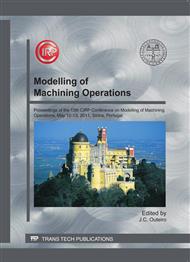[1]
J. C. Becker: Bahngesteuertes Schleifen von Kurbelwellen. PhD Thesis, Universität Hannover. (2004)
Google Scholar
[2]
H. J. Wedeniwski: Technologie des rechnergeführten Schleifens. Anwendungsbereich: Unrundbearbeitung. Tectum-Verl, Marburg. (2007)
Google Scholar
[3]
T. Steffen: Optimierung des Nockenform-Schleifprozesses auf der Basis von Simulation und geometrischer Messtechnik. PhD Thesis, RWTH Aachen. (1995)
Google Scholar
[4]
N. Chiu and S. Malkin.: Computer Simulation for Cylindrical Plunge Grinding. CIRP Annals - Manufacturing Technology Vol. 42, 1 (1993), p.383–387
DOI: 10.1016/s0007-8506(07)62467-6
Google Scholar
[5]
B. Denkena, M. Deichmueller, M. Kröger, and K. M. Popp: Geometrical analysis of the complex contact area for modeling the local distribution of process forces in tool grinding. In Proceedings of the 1st International Conference on Process Machine Interactions (2008), p.289–298
Google Scholar
[6]
K. Weinert, H. Blum, T. Jansen, and A. Rademacher: Simulation based optimization of the NC-shape grinding process with toroid grinding wheels. Prod. Eng. Res. Dev. (Production Engineering) Vol. 1 (2007), p.245–252
DOI: 10.1007/s11740-007-0042-8
Google Scholar
[7]
C. Brecher, M. Esser, and S. Witt.: Interaction of manufacturing process and machine tool. CIRP Annals - Manufacturing Technology Vol. 58, 2 (2009), p.588–607
DOI: 10.1016/j.cirp.2009.09.005
Google Scholar
[8]
M. Deichmüller, B. Denkena, K. M. de Payrebrune, M. Kröger, S. Wiedemann, A. Schröder, and C. Carstensen: Determination of static and dynamic deflections in tool grinding using a dexel-based material removal simulation. In Proceedings of the 2nd International Conforence Process Machine Interactions. (2010)
DOI: 10.1007/978-3-642-32448-2_7
Google Scholar
[9]
O. Schütte: Analyse und Modellierung nichtlinearer Schwingungen beim Außenrundeinstechschleifen. PhD Thesis, Universität Hannover. (2003)
Google Scholar
[10]
Marposs S. p. A.: Fenar L, The Easy Solution for Shape Control. an orbital gauge application able to perform shape analysis without any part uploading. Press report (2003)
Google Scholar
[11]
Leibnitz Universität Hannover.: DE-10-2010-012829 Verfahren zur Erkennung von Aufmaßen während der Bearbeitung von Kreisexzentern. Patent pending, day of registration 28.05.(2010)
Google Scholar
[12]
Information on http://www.automation.siemens.com/doconweb SINUMERIK 840C SIMODRIVE 611-D Installation Instructions. Installation Guide. Accessed 6 December (2010)
Google Scholar
[13]
B. Denkena, H. Henning and R. Fischer: Wirtschaftliche Prozessführung bei der Hartfeinbearbeitung von Kurbelwellen. Optimale Auslegung und aktive Verbesserung von bahngesteuerten Schleifprozessen. ZWF - Zeitschrift für wirtschaftlichen Fabrikbetrieb Vol. 104, 3 (2009), p.141–146
DOI: 10.3139/104.110034
Google Scholar
[14]
H.-K. Tönshoff, J. Peters, I. Inasaki and T. Paul: Modelling and Simulation of Grinding Processes. CIRP Annals - Manufacturing Technology Vol. 41, 2 (1992), p.677–688
DOI: 10.1016/s0007-8506(07)63254-5
Google Scholar
[15]
E. Brinksmeier, J. Aurich, E. Govekar, C. Heinzel, H.-W. Hoffmeister, F. Klocke, J. Peters, R. Rentsch, D. Stephenson and E. Uhlmann: Advances in Modeling and Simulation of Grinding Processes. CIRP Annals - Manufacturing Technology Vol. 55, 2 (2006), p.667–696
DOI: 10.1016/j.cirp.2006.10.003
Google Scholar
[16]
H. Mushardt: Beitrag zur Optimierung mehrstufiger Schleifprozesse. PhD Thesis, Technische Universität Carolo-Wilhelmina zu Braunschweig. (1980)
Google Scholar


